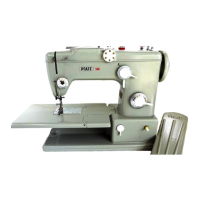Do
not
apply
force
in
replacing
the
barrel
as
this might
cause
bending
of
t,he
com fingers
in
the stitch width regulating mechanism which,
in
turn, might
cause
hard
working
of
this mechanism. The
same
trouble
is
likely to occur
if
the
barrel
is
pushed
in,
or
stands out,
too
for.
If
no
mark
has
been
mode
on the machine arm
beforehand,
turn
the
zigzag
regulator barrel until
a.
on imaginary line
drawn
through
the
red mark h on t
he
barrel (Fig.
51)
posses to
the
right o·f the hinge stud
located
above
it,
and
b.
needle
position lever B points
downward
when
set
at
its central position.
In
all
three
needle positions,
the
rounded
tip
of
the
needle
position com finger
should
be
located
in
the middle
of
the respective section
of
the
needle
position
com.
To double-check this setting, slightly move
the
needle position lever
to
the
right
and
left
of
its
central
position
and
check to see
that
the
zigzag
regulator
arm
does
not
vibrate.
Repeat
this check with
the
needle
position lever set
at
its
left
and
right positions, respective
ly.
While
on
previous machines, the barrel must
be
pushed into
the
machine arm
until the set screw
enters
the small
groove
in
its rim,
on
recent
machines, it
must
be
pushed
in
as
for
as
it will go.
If
stitch width
dial
A should turn heavily on
older
machines, loosen
the
set
screw
and
either
push
in
or
pull
out
the barrel slightly. Then tighten
the
set
screw securely.
Replace the second tension spring (b
in
Fig.
93).
Adjusting
the
Stitch
Width
Control
(See
also
page
88)
To check the correct position
of
the
zigzag
regulator
barrel
in
the
machine
arm, turn stitch width
dial
A to "0".
The sideways movement
of
the connecting
rod
(105193)
must not begin until
stitch width
dial
A
has
been
turned clockwise by three
or
four knurls.
As you depress finger-tip control
F,
the
connecting
rod
should move likewise.
If
these
conditions
ore
not
met, correct the position
of
the
barrel
in
the machine
arm.
After
the
above-mentioned
adjustment
has
been
mode,
also
check
to
see
that
a.
needle
position lever B points
downward
when set
at
its central position,
b.
the
lobe
of
eccentric stud B (Fig.
106)
points
toward
the
balance
wheel
and
the
needle
bar
frame
pitman
is
at
its extreme right-hand position,
66

